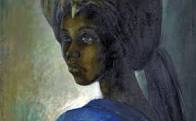Oliver Enwonwu, the son of the late artist and carver, Ben Enwonwu on Thursday sai
The auctioning of Ben Enwonwu’s artwork, “Tutu” for $1.68 million in London recently would inspire many Nigerian artists into hard work and the hope of a bright future.
Oliver Enwonwu, the son of the late artist and carver, Ben Enwonwu on Thursday said this on Thursday in Lagos.
He told the News Agency of Nigeria (NAN) that the artwork was not valued years back when it was initially auctioned.
However, the sale it attracted during the last auctioning would rekindle the love of arts and that there is a bright future for artists in several Nigerians, he said.
NAN reports that Ben Enwonwu’ s “Tutu” was auctioned on March 1, 2018 in London.
The piece, painted in 1974 was lost for almost 40 years before its retrieval in December 2017 from a flat in London.
It was a portrait of the popular Ife Royal Princess called Adetutu Ademiluyi.
The painting was one of three depictions of the princess painted in 1973, which became a symbol of national reconciliation after the end of the Nigerian civil war in 1970.
Late Ben Enwonwu was a Nigerian painter and sculptor, the most influential African artist of the 20th century.
Enwonwu also advised other Nigerian artists to embrace hard work, adding that someday in future their works could be sold exorbitantly like his father’s.
” The auctioning of my late father’s portrait of “Tutu” represents to me a hopeful future for Nigerian artists because when that work was made in 1974, arts was not a respectable profession.
” Arts is gradually becoming relevant in Nigeria now and I call on all artists to be hardworking because their works will be sold at huge rates someday.”
Enwonwu said that the Ben Enwonwu Foundation established in 2003 in memory of his late father was working on documenting his art pieces scattered in various public places.
He said this would involve those that had been commissioned or acquired by organisations like the National Gallery of Modern Arts, National Commission for Museums and Monuments, Nigerian Telecommunications Limited, the former NEPA and more.
” I know we have his works like “Sango” made in 1964, ” The Drummer Boy” in 1978, Anyanwu and more, which are all in public spaces, all will be documented.
” And we will have placards carved around them to indicate the artist that made them, when, where they were made, materials used to make them and in whose possession they were.
” This is important because that is the way they can be properly preserved for more people to see and improve on art works being currently produced, ” he said. (NAN)




 Premier League
Premier League